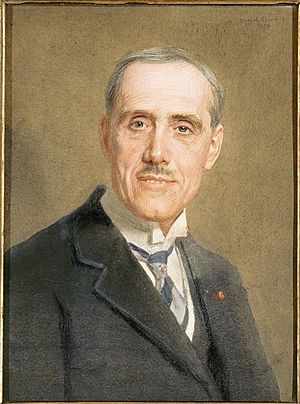Maurice de Broglie, 6th Duke of Broglie facts for kids
Quick facts for kids
Maurice de Broglie
|
|
|---|---|

de Broglie in 1932
|
|
| Born |
Louis César Victor Maurice de Broglie
27 April 1875 |
| Died | 14 July 1960 (aged 85) |
| Awards | Hughes Medal (1928) |
| Scientific career | |
| Fields | Physics X-ray diffraction Spectroscopy |
Maurice de Broglie (born April 27, 1875 – died July 14, 1960) was an important French physicist. He was also the 6th Duke of Broglie. His younger brother, Louis de Broglie, was also a famous physicist who worked on theories.
Maurice de Broglie's Life Story
Growing Up and Family Life
Maurice de Broglie was born in Paris, France. His parents were Victor de Broglie and Pauline de La Forest d'Armaillé.
In 1901, he married Camille Bernou de Rochetaillée in Paris. They had one daughter named Laure, who was born in 1904 but sadly passed away when she was six years old. When his father died in 1906, Maurice became the Duke of Broglie. He passed away in 1960. Since his daughter had died many years before, his brother Louis became the next Duke.
Starting a Career in Science
Maurice de Broglie first joined the French Navy. He spent nine years serving on ships in places like Bizerte and the Mediterranean Sea. During this time, he became very interested in physics, especially in how electromagnetism works.
Even though his family wanted him to stay in the navy, Maurice decided to leave in 1904 to become a scientist. He studied physics in Paris at the Collège de France with a famous scientist named Paul Langevin. Maurice earned his doctorate degree in 1908.
Maurice de Broglie's Scientific Work
Discoveries in X-rays and Light
Maurice de Broglie made big steps forward in studying X-ray diffraction and spectroscopy. X-ray diffraction helps us understand the structure of materials using X-rays. Spectroscopy is about studying how light and matter interact.
During the First World War, he used his knowledge to work on radio communications for the navy. After the war, he continued his research in a large laboratory at his home.
Working with His Brother
Maurice sometimes worked with his younger brother, Louis. Louis also became a physicist, following Maurice's lead. They even wrote a scientific paper together in 1921.
Louis de Broglie became very famous in the 1920s for his theories, which were partly based on their shared research. While Louis was mostly a theorist (meaning he focused on ideas and calculations), Maurice was mainly an experimental physicist. This means Maurice focused on doing hands-on experiments in the lab.
Awards and Recognition
Maurice de Broglie was recognized for his important contributions to science. In 1924, he became a member of the Académie des sciences (French Academy of Sciences). In 1934, he was elected to the Académie française, which is a very respected group that protects the French language. It was a special moment when he later welcomed his own brother, Louis, into the same academy.
In 1942, Maurice took over the physics chair at the Collège de France, which was previously held by his mentor, Paul Langevin. He was also elected to the Royal Society of London in 1940. He received the Royal Society's Hughes Medal in 1928 for his work.
See also


